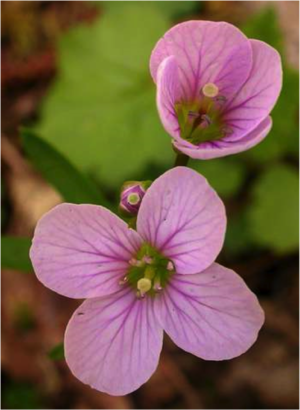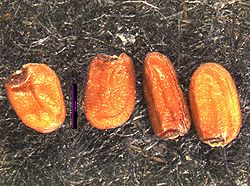Difference between revisions of "Cardamine nuttallii"
(→Taxonomy) |
(→Taxonomy) |
||
| Line 25: | Line 25: | ||
*''Dentaria tenella'' Pursh | *''Dentaria tenella'' Pursh | ||
*''Dentaria gemmata'' (Greene) Howell | *''Dentaria gemmata'' (Greene) Howell | ||
| − | }}< | + | }} |
| + | <ref>Integrated Taxonomic Information System. Retrieved from https://www.itis.gov/servlet/SingleRpt/SingleRpt?search_topic=TSN&search_value=501196</ref> | ||
==Description== | ==Description== | ||
Revision as of 23:42, 17 March 2021
- Latin Name: Cardamine nuttallii
- Family: Brassicaceae
- Common Names: beautiful bittercres, Nuttall's toothwort, slender toothwort
- Synonyms/Misapplications: Cardamine pulcherrima, Cardamine quercetorum, Dentaria tenella
- Codon: CARNUT
Contents
Taxonomy
| Cardamine nutallii | |
|---|---|

| |
| Photo by Ben Legler, 2004. Also featured on Main Page | |
| Scientific classification | |
| Kingdom: | Plantae |
| Subkingdom: | Viridiplantae |
| Phylum: | Tracheophyta |
| Subphylum: | Spermatophytina |
| Class: | Asterales |
| Order: | Asterales |
| Family: | Brassicaceae |
| Genus: | Cardamine L. |
| Species: | Cardamine nuttallii Greene |
| Synonyms | |
| |
Description
General: Glabrous to sparsely pubescent perennial from short, slender, fleshy rhizomes, the stems erect, 1-2 dm. tall. Leaves: Basal leaves long-petiolate, the blades orbicular to cordate, usually simple and scalloped, if deeply lobed the lobes entire; cauline leaves 1-3, grouped above mid-length on the stem, usually with 3-5 lanceolate, entire leaflets 1-4 cm. long. Flowers: Inflorescence of bractless, few-flowered racemes; pedicles ascending to erect, 1-2 cm. long; sepals 4, 3-5 mm. long, purplish, the outer pair saccate at the base; petals 4, pink to reddish or purplish, 9-14 mm. long; stamens 6; style slender, 3-6 mm. long. Fruit: Siliques linear, 1.5-5 cm. long and 1.5 mm. broad; seeds in 1 series.
Bloom Period
Distribution
Washington to California, chiefly west of the Cascades.
Habitat
Ecological Setting-Dry ground, low to moderate elevations.
Uses
Propagation
Seed
Seed sample from: 2007
Average Measurement: 1.75 x 1.1 x 0.7
Measurement range: L: 1.5 – 2.1, W: 1 – 1.3, D: 0.2 - 0.9
Features
Shape: Seeds a variety of shapes, mostly slightly flattened ellipses, with the hilum to opposite apex being the longest measurement. Some seeds lenticular in shape.
Additional Structures: Cotyledons accumbent with sulcus present in some.
Color: Seeds golden brown with a tan or white hilum surrounded by a darker brown color.
Surface: Seeds are deeply wrinkled or pitted. Wrinkles commonly oriented longitudinally, but not always. Seeds slightly lustrous.
Latitudinal cross section: elliptical ![]()
Longitudinal cross section: elliptical ![]()
Basic Explanations and Assumptions:
The dimensions for the seeds are length x width x depth. The location of the hilum is used as the base of the seed, and the length is measured from hilum to the opposite apex. Where a style is present, the length is measured from the hilum to the bottom of the style. Width is measured at a right angle to the length at the widest part. Depth is measured at a right angle to the intersection of height and width lines.
Measurements included are the mean average for each measurement of ten separate seeds.
All measurements in millimeters unless otherwise noted.
References
- ↑ Integrated Taxonomic Information System. Retrieved from https://www.itis.gov/servlet/SingleRpt/SingleRpt?search_topic=TSN&search_value=501196




